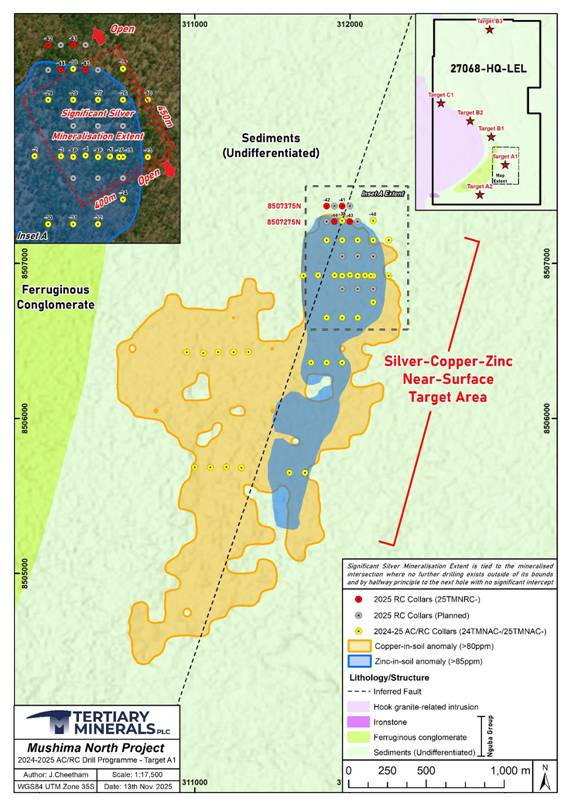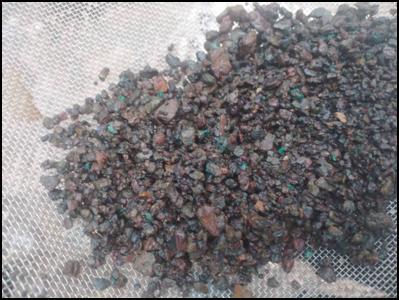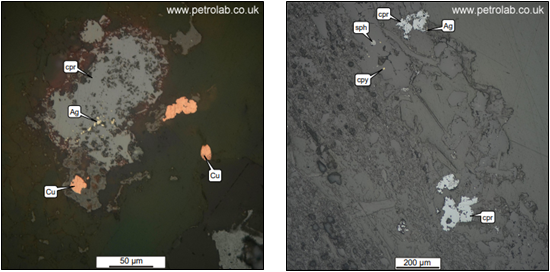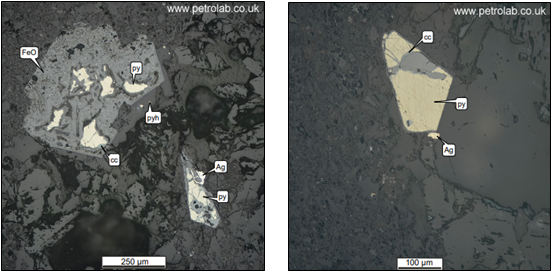13th Nov 2025 07:00

13 November 2025
Tertiary Minerals plc
("Tertiary" or the "Company")
Drilling Update at Target A1, Mushima North Project, Zambia
Best pXRF result to date: 95m intersection grading 0.4% copper
pXRF silver grades up to 246g/t
Tertiary Minerals plc (AIM: TYM) is pleased to provide an update on work programmes at Target A1 and preliminary results from portable X-Ray Fluorescence ("pXRF") analysis of drill samples.
Target A1 is a polymetallic (silver-copper-zinc) prospect, part of the Mushima North Project ("Mushima North" or the "Project") and is located in the prospective Iron-Oxide-Copper-Gold region of Zambia. Target A1 is located 28km to the east of the historic Kalengwa copper-silver mine which is currently under redevelopment.
Highlights:
Ø 4 holes completed in this Phase 3 drill programme for a total of 481m with the deepest hole having been drilled to a depth 127m. Remaining programme put on hold due to the early start of unusually heavy rains.
Ø Initial results extremely positive, with visible secondary copper mineralisation observed over a 20m interval and sulphide mineralisation observed towards the base of the holes.
Ø High pXRF silver values of up to 246 g/t and broad intervals (>20 g/t) in line with previous pXRF results (the pXRF analysis for silver is semi-quantitative, these values are therefore indicative only. Silver intervals will be released following laboratory analysis).
Ø Drill intersections include (pXRF analysis for copper and zinc only, downhole widths, true widths unknown):
o 95m at 0.41% Cu from 10m downhole (hole 25TMNRC-043).
§ Including: 47m at 0.58% Cu from 58m downhole, and
§ 25m at 0.75% Cu from 80m downhole, and
§ 8m at 1.13% Cu from 89m downhole.
o 30m at 0.17% Cu from 12m downhole (hole 25TMNRC-044).
§ Including: 25m at 0.23% Cu from 51m downhole, and
§ 3m at 0.6% Cu from 60m downhole.
Ø Initial mineralogy identifies native silver and native copper, along with other copper-bearing minerals.
Ø JORC Exploration Target work to now commence.
Richard Belcher, Managing Director of Tertiary Minerals plc, commented:
"Whilst the pause of the planned drill programme due to the onset of heavy rains earlier than anticipated is frustrating, the preliminary results from the first few holes are extremely encouraging, have extended the area of known mineralisation in the north and at depth, and support our current exploration model. We will now bring forward programmes originally planned for after the drilling in Q1 2026 to maintain the positive momentum going forward.
"These programmes include the JORC Exploration Target work, which will provide valuable guidance on the resource potential of Target A1 in terms of a range of tonnages and grades, as well as further mineralogical studies to better understand the mineralisation and deportment of the metals of interest.
"The above studies will continue to advance this exciting project and the results of these studies, along with the laboratory assay results from the four holes in this programme, will be communicated in further press releases in the coming months. This will all feed into the next drill programme planned to commence at the start of the dry season next year and will support our aim of producing a Maiden Mineral Resource Estimate in 2026.
"I look forward to updating shareholders on these results in due course as well as providing updates on our wider exploration portfolio in Zambia and elsewhere."
Phase 3 Drill Programme
A programme of approximately 1,000m Reverse Circulation ("RC") was planned as part of Phase 3 drilling. Initially drilling proved very promising, but heavy and earlier than expected rains have resulted in the pause of this programme until after the rains, most likely in March/April 2026. Four vertical holes were completed with a maximum depth of 127m testing the northern extent of the currently open-ended mineralisation footprint.
The four drill holes now being reported, and described below, are located on two east-west drill lines, 8507275N and 8507375N (see Figure 1 below. Drill line 8507375N represents the most northern drill traverse drilled to date.
· 25TMNRC-041: Located on a two drill-hole line with 25TMNRC-042. The drill hole was drilled vertically to a downhole depth of 112m. The hole was designed to test the continuation of the mineralisation to the north from drill line 8507275N.
· 25TMNRC-042: Located on a two drill-hole line with 25TMNRC-042. The drill hole was drilled vertically to a downhole depth of 127m. The hole was designed to test the continuation of the mineralisation to the north from drill line 8507275N.
· 25TMNRC-043: Located on a three drill-hole line with 25TMNAC-038 and 25TMNRC-044 (drill line: 8507275N). The drill hole was drilled vertically to a downhole depth of 121m. The hole was designed to test the continuation of the mineralisation to the east from drill hole 25TMNAC-038.
· 25TMNRC-044: Located on a three drill-hole line with 25TMNAC-038 and 25TMNRC-043 (drill line: 8507275N). The drill hole was drilled vertically to a downhole depth of 121m. The hole was designed to test the continuation of the mineralisation to the west from drill hole 25TMNAC-038.
 Figure 1. Location map of Target A1 showing soil sample results for copper and zinc, and the collar locations for the previous (Phase 1 and 2) and Phase 3 drilling programme (both planned holes: grey circles, and drilled holes: red circles).
Figure 1. Location map of Target A1 showing soil sample results for copper and zinc, and the collar locations for the previous (Phase 1 and 2) and Phase 3 drilling programme (both planned holes: grey circles, and drilled holes: red circles).
The pXRF results for copper (and zinc) of the above holes are provided below, and the intervals will now be sent to the certified independent laboratory for multi-element analysis, including silver.
 |
Note to Table 1:
· Calculated intersections (down hole, true width unknown) are weighted averages based on zinc (intervals start and end with ≥0.2% Zn, and the average grade cut-off is 0.2% Zn and allow for up to 3m internal dilution) or copper (intervals start and end with ≥0.1% Cu, and the average grade cut-off is 0.1% Cu) and include up to 3m of internal dilution allowed).
· Reported values were produced using a pXRF analyser to test unprepared samples and as such are of a preliminary nature but provide an indication of potential mineralisation.
These results provide further evidence for higher-grade copper mineralisation in the north of the target area and the continuation of the silver mineralisation. Whilst the pXRF results for silver are not sufficiently accurate to allow grade intervals to be reported, the pXRF silver results from this Phase 3 programme are, in general, consistent with the pXRF results recorded from drill holes in this area during Phase 2 drilling which, on analysis at an independent laboratory, returned reportable silver intersections.
The current surface footprint of the mineralisation (approximately 450m by 400m) remains open still to the north/northwest and south/southeast, while the maximum vertical depth of oxide mineralisation has increased by an additional 21m, from 84m to 105m (Figure 2). The potential for primary sulphide mineralisation, underneath the near-surface oxide mineralisation is, as yet, largely untested.

Figure 2. Drill cross-section 8507275N (location shown on Figure 1) showing analytical results for silver and selected copper values for drill holes 25TMNAC-038 and 25TMNAC-039. See Table 1 notes for further information.

Figure 3. Field sample from drill hole 25TMNRC-043 showing visible secondary copper mineralisation (the green mineral, predominantly malachite).
Mineralogy
Two samples from mineralised intervals in Phase 2 drill holes were submitted to Petrolab Ltd in the UK for mineralogical descriptions.
Both the sample compositions and textures suggest a volcanoclastic (tuff-tuffaceous) host rock to the mineralisation within the oxidised, near-surface zone. Mineralisation (with quartz and carbonates) is associated with hydrothermal fluids and deposition of mineralisation with vugs and fractures in the host rocks. The copper minerals observed are primarily native copper (Cu) and cuprite (Cu2O) within the vugs and fractures. Silver (Ag) was only observed as native silver as blebs within the vugs or later infilling of fractures within quartz, carbonates and the copper minerals. The main sulphides observed were pyrite (FeS) along with trace amounts of chalcopyrite (CuFeS2), chalcocite (Cu2S), sphalerite ((Zn,Fe)S) and pyrrhotite (Fe(1-x)S) (Figures 4 & 5).
Part of the summary report by Petrolab Ltd states: "The ore mineralisation and degree of limonitisation is consistent with gossanous weathering of a well mineralised tuffaceous volcaniclastic deposit. Ag [silver] and Cu [copper] have likely been remobilised from prior existing sulphides and concentrated through supergene enrichment processes."
 |
Figure 4. Reflected light images from the mineralogical sample TYM_TS001.
Left image: A partially filled vug in the volcanoclastic with native copper (Cu) and iron oxidation and large anheadral crystals of cuprite (cpr) with silver (Ag) infilling fractures.
Right image: A partially filled vug within the volcanoclastic with cuprite (cpr), blebs of sphalerite (sph), chalcopyrite (cpy) and native silver (Ag).

Figure 5. Reflected light images from the mineralogical sample TYM_TS002.
Left image: Pyrite(py) grain now heavily oxidised (FeO) with a thin alteration rim of chalcocite (cc). Native silver (Ag) occurs as infill within fractures within the sulphides.
Right image: Pyrite crystal within the volcanoclastic matrix with local chalcocite (cc) alteration. Note the native silver (Ag) crystal next to the pyrite.
Target A1
Target A1 is a large copper-in-soil anomaly (3.1km by 1.7km) with copper values up to 302ppm (per pXRF) associated with a 1.7km by 0.5km zinc- and coincidental 1.3km by 0.3km silver-in-soil anomaly.
Phase 1 drilling in 2024 targeted the copper-in-soil anomaly and returned broad but generally low-grade copper mineralisation as reported in the news release dated 28 October 2024 (e.g. 57m at 0.20% Cu from 14m downhole, hole 24TMNAC-004). Higher grade copper mineralisation within these broader zones was also returned (e.g. 6m at 0.58% Cu within 35m at 0.21% Cu, from 22m downhole, hole 24TMNAC-024). Drilling over the silver- and zinc-in-soil anomaly (drill line: 8506925N) identified wide and thick, near surface silver mineralisation associated with low-grade copper and/or zinc mineralisation.
The Phase 2 drill programme (1,116m), as discussed above, targeted the silver- and zinc-in soil anomaly. The silver mineralisation has now been confirmed to extend approximately 450m northwest-southeast and by 400m northeast-southwest and to a depth from near surface to 84m and it remains open-ended both to the north/northwest, south/southeast and at depth.
The mineralisation at Target A1 is associated with a massive, haematitic and carbonaceous silty-sandy conglomerate. Copper mineralisation observed to date is predominantly in the form of secondary copper minerals malachite, chrysocolla and cuprite. Native copper, chalcocite and chalcopyrite are also observed. Silver mineralisation is so far only observed as native silver and zinc mineralisation is observed as sphalerite. Elevated bismuth (up to 991 g/t), and the critical metals antimony (up to 0.21%) and gallium (up to 40 g/t) are also associated with the mineralisation in places.
Mushima North Project
The Mushima North Copper Project (Licence 27068-HQ-LEL) is held through Group company Copernicus Minerals Limited ("Copernicus"), which is 90% owned by Tertiary Minerals (Zambia) Limited and 10% by local partner, Mwashia Resources Limited.
The Project lies 20km to the east of the Kalengwa copper mine in northwest Zambia, one of the highest-grade copper deposits ever to be mined in the country. In the 1970s, high-grade ore, average approximately 11% Cu copper, was trucked for direct smelting at other mines in the Copperbelt. The Kalengwa mine is currently under redevelopment and is expected to produce 15,000 tonnes of copper annually.
Numerous other geochemical and/or geophysical targets (A2, B1, B2, B3, C2) are yet to be drill tested. Many of these are located within 12km of Target A1.
 |
Figure 6. Geological map of the Mushima North Project showing the locations of the priority targets within the licence and their distance out from Target A1 based on 5 km radius rings.
Sampling, Analysis and QAQC
Sampling was undertaken at 1m intervals, and two subsamples were collected from each interval using a riffle splitter: one for potential laboratory analysis, the other for future reference.
Samples have been initially analysed on site using a pXRF analyser for zinc and copper and, more recently, silver. Analysis protocol included multiple point (three) analyses per sample (unprepared sample analysed through a thin plastic sample bag) and the inclusion of Certified Reference Material, blanks and duplicate samples as part of an internal Quality Assurance procedure. Given the nature of the unprepared sample and point analysis, this method is used as a preliminary exploration technique to provide an approximate quantitative measure of copper and zinc mineralisation only.
Samples from selected drill holes based on the initial pXRF results will now be sent to the independent laboratory ALS Global in South Africa for analysis for a range of elements using a four-acid digest, method code ME-ICP61 (including silver, copper, zinc, bismuth, antimony and gallium). QA samples (Certified Reference Material, duplicates, blanks) will be inserted and monitored as part of the QAQC protocol.
Reported drill hole intersection thicknesses are down-hole thicknesses and true thicknesses are unknown as the geology of the drill area is still uncertain. Intersections are weighted averages on zinc (using a cut-off grade of 0.2% Zn) or copper (using a cut-off grade of 0.1% Cu) with up to 3m internal dilution and intersections starting and finishing with 0.1% Cu or 0.2% Zn, respectively.
Further Information:
Tertiary Minerals plc | |
Richard Belcher, Managing Director | +44 (0) 1625 838 679 |
SP Angel Corporate Finance LLP, Nominated Adviser and Broker | |
Richard Morrison/Jen Clarke | +44 (0) 203 470 0470 |
AlbR Capital Limited, Joint Broker | |
Lucy Williams/Duncan Vasey | +44 (0) 207 469 0930 |
Market Abuse Regulation
The information contained within this announcement is deemed by the Company to constitute inside information as stipulated under the Market Abuse Regulation (EU) No. 596/2014 as it forms part of UK domestic law by virtue of the European Union (Withdrawal) Act 2018 ('MAR'). Upon the publication of this announcement via Regulatory Information Service ('RIS'), this inside information is now considered to be in the public domain.
Cautionary Note Regarding Forward-Looking Statements
The news release may contain certain statements and expressions of belief, expectation or opinion which are forward looking statements, and which relate, inter alia, to the Company's proposed strategy, plans and objectives or to the expectations or intentions of the Company's directors. Such forward-looking statements involve known and unknown risks, uncertainties, and other important factors beyond the control of the Company that could cause the actual performance or achievements of the Company to be materially different from such forward-looking statements. Accordingly, you should not rely on any forward-looking statements and, save as required by the AIM Rules for Companies or by law, the Company does not accept any obligation to disseminate any updates or revisions to such forward-looking statements.
Competent Persons Statement
The technical information in this release has been compiled and reviewed by Dr. Richard Belcher (CGeol, EurGeol) who is a qualified person for the purposes of the AIM Note for Mining and Oil & Gas Companies. Dr. Belcher is a chartered fellow of the Geological Society of London and holds the European Geologist title with the European Federation of Geologists.
About Tertiary Minerals plc
Tertiary Minerals plc (AIM: TYM) is an AIM-traded mineral exploration and development company whose strategic focus is on energy transition metals. The Company's projects are all located in stable and democratic, geologically prospective, mining-friendly jurisdictions. Tertiary's current principal activities are the discovery and development of copper and precious metal mineral resources in Zambia and Nevada, USA.
Related Shares:
Tertiary Minerals